Exploring the impressive dams of India offers a unique blend of engineering marvels and natural beauty. These dams not only support the country’s water and power needs but also provide incredible travel experiences. Here’s a guide to the 10 largest dams in India by different criteria, along with tips for planning your visit.
1. Tehri Dam
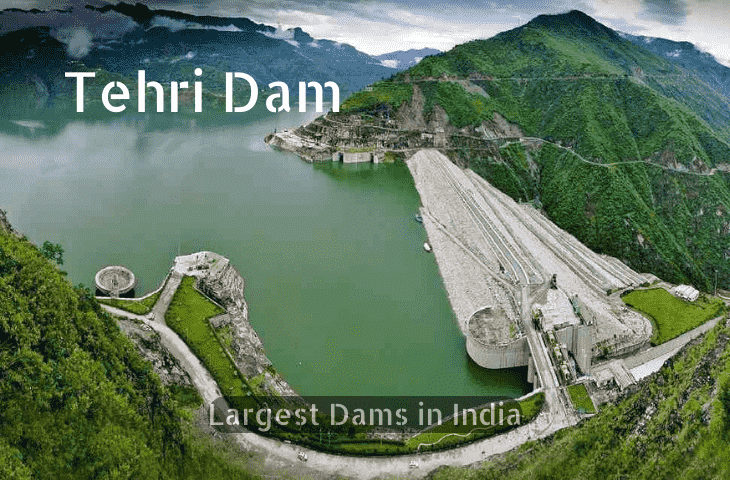
Location: Uttarakhand
Height: 260.5 meters
Significance: The tallest dam in India, built on the Bhagirathi River.
What to Do: Enjoy panoramic views, boating, and visit the Tehri Lake Festival.
Tehri Dam, the highest dam in India and among the tallest in the world, functions as a multipurpose structure providing hydroelectric power, irrigation, and drinking water. This landmark is also a popular tourist spot, offering stunning vistas of the Himalayas and the Bhagirathi River.
Top Attractions Near Tehri Dam:
- Tehri Lake
- New Tehri Town
- Devprayag
- Surkanda Devi Temple
- Dhanaulti
Activities at Tehri Dam:
- Boating
- Rafting
- Kayaking
- Jet Skiing
- Paragliding
- Camping
- Trekking
How to Reach Tehri Dam
You can reach Tehri Dam by traveling by road from Dehradun, Rishikesh, Haridwar, or Delhi. The closest airport is Jolly Grant Airport in Dehradun, situated approximately 91 km away. The nearest railway station is in Rishikesh, around 75 km from the dam. Additionally, you can opt for a bus or taxi from these locations to arrive at Tehri Dam.
Read more: Which Is The Largest Dam In The World?
2. Bhakra Nangal Dam
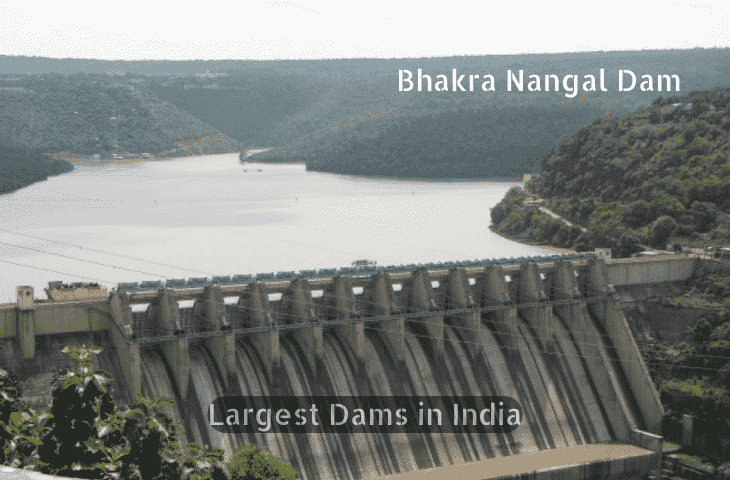
Location: Himachal Pradesh and Punjab
Height: 226 meters
Significance: One of the highest gravity dams in the world, built on the Sutlej River.
What to Do: Explore Gobind Sagar Lake, fishing, and visit nearby Anandpur Sahib.
The Bhakra Nangal Dam stands as the second-largest dam in India by reservoir capacity and ranks among the highest gravity dams worldwide. This multipurpose dam plays a crucial role in irrigation, power generation, and flood control. Additionally, it serves as a major tourist attraction, drawing visitors who wish to marvel at the engineering feat and enjoy the region’s natural beauty.
Top Attractions near Bhakra Nangal Dam:
- Gobind Sagar Lake
- Bhakra Dam Museum
- Naina Devi Temple
- Anandpur Sahib
- Nangal Wetland
Activities at Bhakra Nangal Dam:
- Boating
- Fishing
- Sightseeing
- Photography
- Birdwatching
How to Get to Bhakra Nangal Dam:
You can get to Bhakra Nangal Dam by road from Chandigarh, Nangal, or Rupnagar. The closest airport is Chandigarh Airport, around 75 km away. The nearest railway station is Nangal Dam, approximately 15 km away. You can also take a bus or taxi from these locations to reach Bhakra Nangal Dam.
Read More:- Top 10 Great Leaders of the World
3. Sardar Sarovar Dam
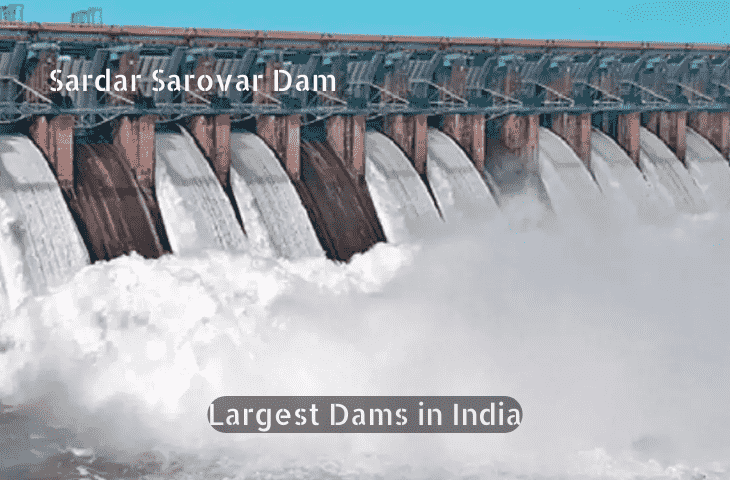
Location: Gujarat
Length: 1,210 meters
Significance: Part of the Narmada Valley Project, it’s one of the largest dams in terms of volume.
What to Do: Visit the Statue of Unity, boat rides, and wildlife sanctuary.
The Sardar Sarovar Dam is India’s largest dam by reservoir capacity and ranks among the world’s largest. This multipurpose dam serves to provide water, electricity, and foster development for the states of Gujarat, Madhya Pradesh, Maharashtra, and Rajasthan. It is also a significant tourist destination, drawing visitors keen to see the Statue of Unity, the tallest statue in the world, situated nearby.
Top Attractions Near Sardar Sarovar Dam:
- Statue of Unity
- Valley of Flowers
- Sardar Sarovar Garden
- Shoolpaneshwar Wildlife Sanctuary
- Zarwani Waterfall
Activities at Sardar Sarovar Dam:
- Boating
- Helicopter rides
- Light and sound show
- Jungle safari
- Trekking
How to Reach Sardar Sarovar Dam
You can travel to Sardar Sarovar Dam by road from Vadodara, Ahmedabad, Surat, or Rajkot. The closest airport is Vadodara Airport, approximately 91 km away. The nearest railway station is in Bharuch, around 75 km away. You can also opt for a bus or taxi from these locations to reach Sardar Sarovar Dam.
Read More:- Top 10 Richest Sports Franchises in the World 2024
4. Hirakud Dam
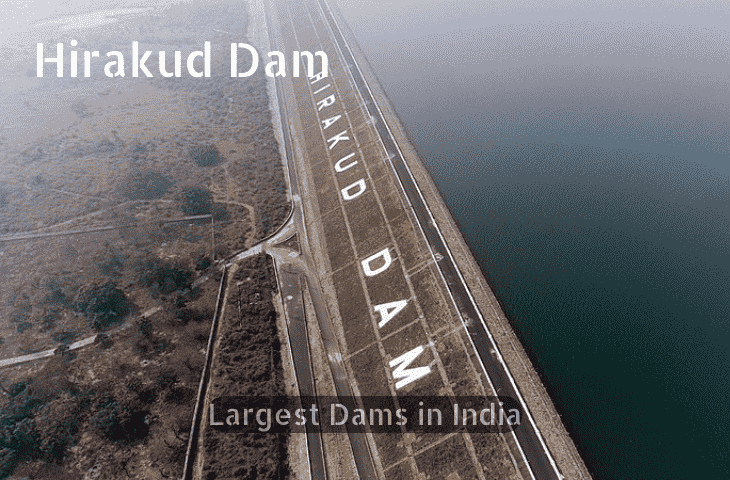
Location: Odisha
Length: 4,800 meters
Significance: The longest dam in India, built on the Mahanadi River.
What to Do: Enjoy scenic drives along the dam, visit the Gandhi Minar, and nearby wildlife sanctuary.
Top Attractions near Hirakud Dam:
- Debrigarh Wildlife Sanctuary
- Huma Temple
- Samaleswari Temple
- Ghanteswari Temple
- Leaning Temple of Huma
Activities at Hirakud Dam:
- Boating
- Cruising
- Sightseeing
- Photography
- Wildlife Watching
To visit Hirakud Dam, you can travel by road from Sambalpur, Bhubaneswar, Cuttack, or Rourkela. The closest airport is in Bhubaneswar, approximately 195 km away. The nearest railway station is Sambalpur Junction, around 16 km from the dam. Alternatively, you can take a bus or hire a taxi from these locations to reach Hirakud Dam.
Read More:-Top 10 Richest Footballer in the World 2024
5. Nagarjuna Sagar Dam

Location: Telangana
Height: 124 meters
Significance: One of the world’s largest masonry dams, built on the Krishna River.
What to Do: Explore Nagarjunakonda Island, visit the museum, and boat rides.
Nagarjuna Sagar Dam ranks as India’s third-largest reservoir and stands out globally as one of the largest masonry dams. This multipurpose marvel serves vital roles in irrigation, power generation, and supplying drinking water. Beyond its utilitarian functions, it draws numerous tourists eager to delve into the area’s abundant cultural and historical treasures.
Notable attractions around Nagarjuna Sagar Dam include Nagarjunakonda Island, Ethipothala Waterfall, Nagarjuna Sagar Wildlife Sanctuary, Anupu, and Sri Parvata Arama.
Visitors can engage in a variety of activities such as boating, cruising, sightseeing, photography, exploring museums, and wildlife observation.
To get to Nagarjuna Sagar Dam, you can travel by road from Hyderabad, Vijayawada, Guntur, or Nalgonda. The closest airport is Hyderabad Airport, approximately 151 km away. The nearest railway station is Macherla, around 23 km from the dam. Additionally, you have the option to take a bus or taxi from these locations to reach Nagarjuna Sagar Dam.
6. Indira Sagar Dam

Location: Madhya Pradesh
Height: 92 meters
Significance: Known for its large reservoir, built on the Narmada River.
What to Do: Fishing, boating, and explore nearby Omkareshwar Temple.
Indira Sagar Dam ranks among India’s largest reservoirs and stands as a prominent hydroelectric venture, serving crucial roles in irrigation, power generation, and flood management. Beyond its functional importance, the dam attracts numerous tourists seeking peaceful vistas and the chance to explore its vast reservoir.
Key Attractions Nearby:
- Hanuwantiya Island
- Sailani Island
- Omkareshwar Temple
- Maheshwar Fort
- Mandleshwar
Activities Offered:
- Boating and cruising
- Sightseeing and photography
- Island hopping adventures
- Visits to nearby temples
To reach Indira Sagar Dam, you can access it via road connections from cities like Indore, Bhopal, Ujjain, or Khandwa. The closest airport is Indore Airport, approximately 146 km away, while Khandwa Railway Station, around 49 km distant, serves as the nearest railway hub. Alternatively, buses and taxis are available from these locations to transport you directly to Indira Sagar Dam.
Read More:- Top 10 Most Spoken Languages In The World In 2024
7. Koyna Dam
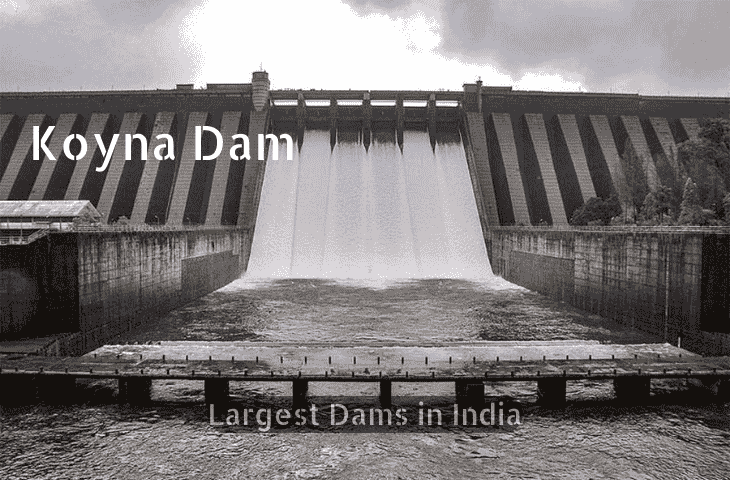
Location: Maharashtra
Height: 103 meters
Significance: Built on the Koyna River, known for its hydroelectric power project.
What to Do: Trekking in the Koyna Wildlife Sanctuary, visit Nehru Gardens, and boating.
The Koyna Dam, located in Maharashtra, India, stands as one of the largest concrete and rubble dams in the country. It spans the Koyna River, originating from the Sahyadri mountains’ Mahabaleshwar region. Positioned on the state route connecting Chiplun and Karad in Koyna Nagar, Satara district, within the Western Ghats, this dam is pivotal in harnessing hydroelectric power. Ranking second only to the Tehri Dam Project, the Koyna Hydroelectric Project boasts India’s largest capacity in this regard. It serves nearby communities with electricity and ensures water supply to Paschim Maharashtra. Moreover, the dam significantly mitigates monsoon-related flood risks by regulating the Koyna River flow. Its reservoir, Shivsagar Lake, formed by the dam’s catchment area, stretches over 50 kilometers. With a hydroelectric capacity of 1,960 MW, the Koyna Dam stands as a crucial infrastructure for both power generation and flood control in the region.
8. Tungabhadra Dam
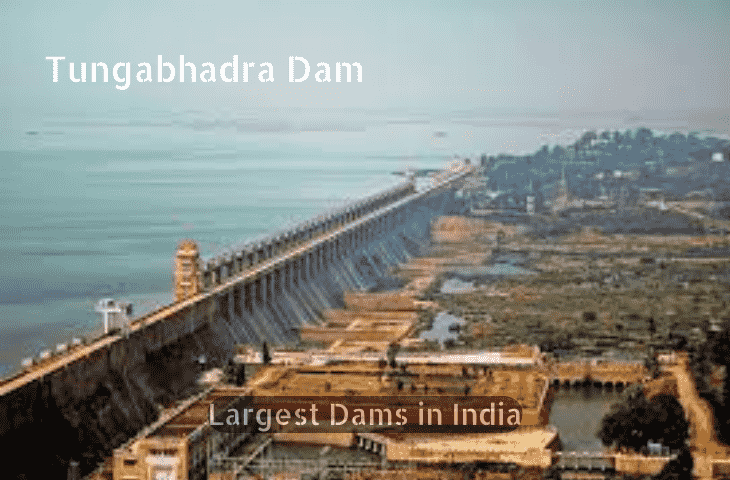
Location: Karnataka
Length: 2,449 meters
Significance: Built on the Tungabhadra River, it serves irrigation and power generation needs.
What to Do: Bird watching, exploring Vijayanagara ruins, and boat rides.
This collaborative project between the Governments of Andhra Pradesh and Karnataka is overseen by the Tungabhadra Board, established by the Government of India on October 1, 1953, to manage administrative aspects. The Tungabhadra Board operates two powerhouses: the TB Dam powerhouse, located on the right side of the Tungabhadra Dam, houses four 9 MW units. Additionally, the Hampi powerhouse utilizes tailrace waters from the dam powerhouse and also houses four 9 MW units. The Tungabhadra Dam itself is situated on the Tungabhadra River, approximately 6 kilometers from Hospet in Bellary District. At its full reservoir level (FRL) of 1633 feet, it has a total capacity of 100.855 thousand million cubic feet (TMC) with a live storage capacity of 95 TMC. The water stored in the reservoir is allocated among the participating states in accordance with the Krishna Water Tribunal Award.
Read More:- Top 10 Strongest Air Forces Of The World, Complete List
9. Rihand Dam
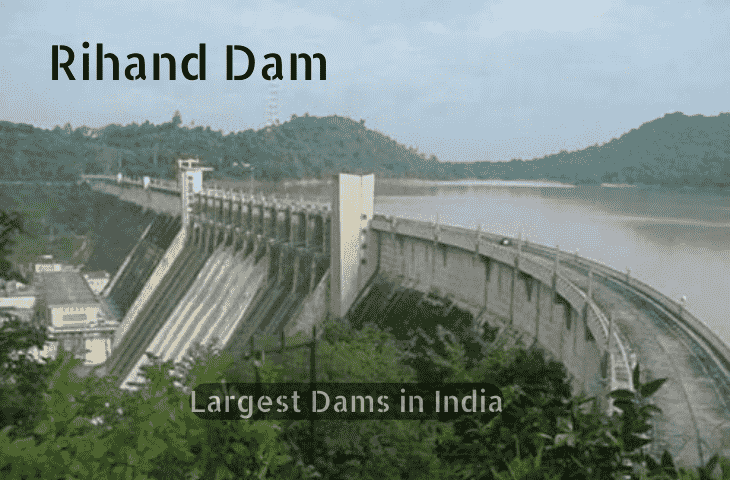
Location: Uttar Pradesh
Height: 91 meters
Significance: Built on the Rihand River, forms the Govind Ballabh Pant Sagar reservoir.
What to Do: Boating, fishing, and exploring the reservoir’s scenic beauty.
Rihand Dam, also known as Govind Ballabh Pant Sagar, is a substantial concrete gravity dam situated in Pipri, Sonbhadra District, Uttar Pradesh. It spans the Rihand River, a tributary of the Son River, and its reservoir straddles the border of Madhya Pradesh and Uttar Pradesh.
This dam’s catchment area covers parts of Uttar Pradesh, Madhya Pradesh, and Chhattisgarh, with its irrigation waters reaching downstream Bihar. Constructed between 1954 and 1962, Rihand Dam measures 934.21 meters in length and stands at a maximum height of 91.44 meters. Comprising 61 independent blocks with ground joints, it houses a powerhouse at its base, generating 300 MW through six units of 50 MW each.
The intake structure, positioned between blocks 28 to 33, supports operational functionality. The dam, currently in a state of distress, necessitates rehabilitation efforts both for the dam structure and the powerhouse. With a Full Reservoir Level (F.R.L.) of 268.22 meters, it holds approximately 8.6 million acre-feet of water, making it one of India’s largest reservoirs by gross storage capacity.
The dam’s construction involved the displacement of nearly 100,000 people. Numerous super thermal power stations, including Singrauli, Vindyachal, Rihand, Anpara, Sasan, and Renukoot, are located within its catchment area. Runoff water with high alkalinity from ash dumps, some situated within the reservoir area, contributes to increased water alkalinity and pH levels. This affects agricultural lands downstream, turning them into alkali soils when used for irrigation.
10. Idukki Dam
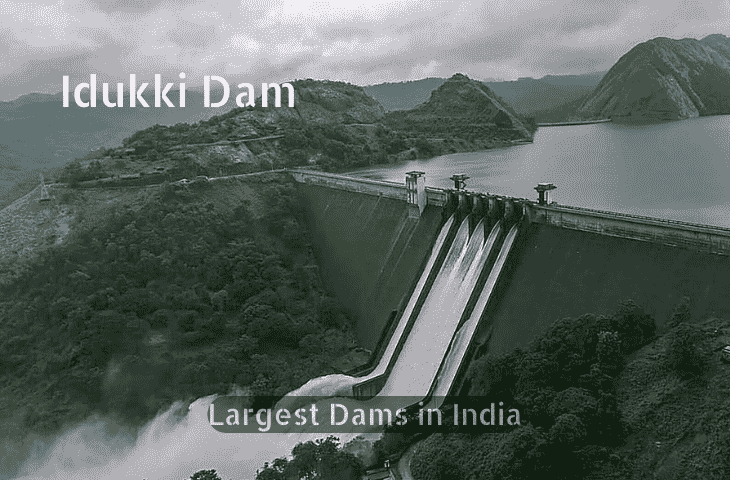
Location: Kerala
Height: 168.91 meters
Significance: An arch dam built on the Periyar River, known for its height and beauty.
What to Do: Visit Idukki Wildlife Sanctuary, boating in the reservoir, and trekking.
The Idukki Arch Dam stands as India’s tallest and among Asia’s top arch dams, harnessing hydroelectric power. Its unique double curvature design not only powers the region but also draws tourists keen on exploring the stunning vistas and diverse wildlife of the Western Ghats.
Nearby attractions include the Idukki Wildlife Sanctuary, Kulamavu Dam, Painavu, Cheruthoni Dam, and Hill View Park, offering visitors ample opportunities for sightseeing and experiencing the natural beauty.
Activities around the dam include boating, sightseeing, photography, trekking through scenic trails, and observing the rich wildlife in its natural habitat.
Planning Your Trip
- Best Time to Visit: The ideal time to visit these dams is during the post-monsoon season (September to March) when the reservoirs are full, and the weather is pleasant.
- Travel Tips: Research each dam’s accessibility, as some are located in remote areas. Consider guided tours for an informative experience.
- Activities: Most dams offer activities such as boating, fishing, and trekking. Check local guidelines and availability.
What to Expect
- Stunning Views: Panoramic vistas of the reservoirs, rivers, and surrounding landscapes.
- Cultural Insights: Some dams are located near historical sites and cultural landmarks, offering a blend of natural and cultural experiences.
- Wildlife: Many dams are adjacent to wildlife sanctuaries, providing opportunities for wildlife spotting.
Exploring these dams will not only give you an insight into India’s engineering prowess but also allow you to witness some of the most breathtaking landscapes and vibrant local cultures.


